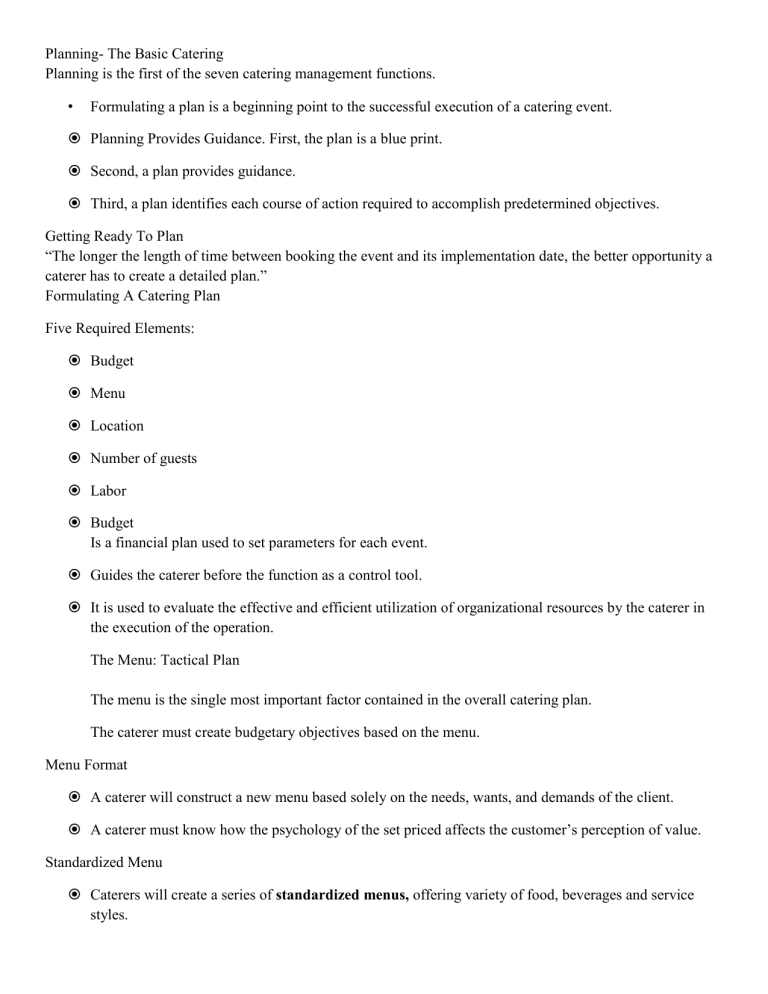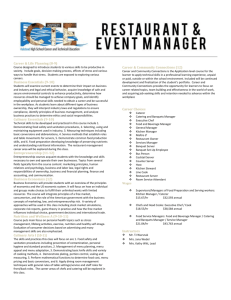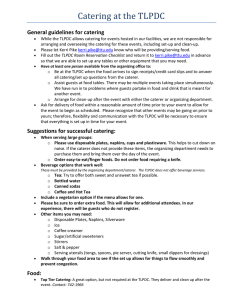Catering Planning: Essential Guide to Event Management
advertisement

Planning- The Basic Catering Planning is the first of the seven catering management functions. • Formulating a plan is a beginning point to the successful execution of a catering event. Planning Provides Guidance. First, the plan is a blue print. Second, a plan provides guidance. Third, a plan identifies each course of action required to accomplish predetermined objectives. Getting Ready To Plan “The longer the length of time between booking the event and its implementation date, the better opportunity a caterer has to create a detailed plan.” Formulating A Catering Plan Five Required Elements: Budget Menu Location Number of guests Labor Budget Is a financial plan used to set parameters for each event. Guides the caterer before the function as a control tool. It is used to evaluate the effective and efficient utilization of organizational resources by the caterer in the execution of the operation. The Menu: Tactical Plan The menu is the single most important factor contained in the overall catering plan. The caterer must create budgetary objectives based on the menu. Menu Format A caterer will construct a new menu based solely on the needs, wants, and demands of the client. A caterer must know how the psychology of the set priced affects the customer’s perception of value. Standardized Menu Caterers will create a series of standardized menus, offering variety of food, beverages and service styles. The client selects the menu with the best fit to their needs and price range and is not usually permitted to substitute items. Master Menu Permits the client to create their own menu based on their budget. The caterer will present a variety of menu selections from a master menu similar to a la carte menu. Complexity of the Plan The complexity of a plan grows when the size of the event increases. Planning for a Catering Event All caterers must identify objectives - To identify customer’s needs and wants Caterer must over produce - focusing on the little things that can be added within the budget to make the event look more elegant and exceed a customer’s expectation Ingredient for Success: to satisfy customer needs, the caterer must over produce to exceed customer expectations Creativity - is a skill resulting from caterer’s experience Skill of interpreting customers needs - helps caterer to plan successful catering event Ingredient for Success: We cannot be all things to people Addition of extra frills and decorative touches on a buffet table can add eye appeal Colors also attract the eye - using different colored table cloths coordinated with the color of the food can accent the items Planned presentation of the food - brings organization to the event Objectives become operational tasks - Singular activities that must be executed to accomplish an objective. Caterer must identify approximate no. of employees - facilitates employee scheduling, contributes to identifiable and controllable labor and its related costs, and leads to the creation of a budget for the event Delegation Each bundle task is delegated to a management team member, who then assigns those jobs to employee Successful caterer have good, reliable, trusted people on staff Approximate level of authority must be delegated to each member Caterer must exercise management control techniques Common catering management techniques: Management team meetings One on one interaction with key people Caterer can implement control techniques The caterer may follow up question like: Is the team member responsible for the purchasing function doing the job? Has someone received prices from the suppliers on the major food items on the menu? Have the menu plan’s food and beverage needs been discuss with suppliers? Caterer must know where to find items that needed in the event and its approximate cost Ingredient for Success: Outside suppliers are as important as a caterer’s own key personnel Implementation of plan Putting the plan into action, the process of implementing each piece of the plan into: day to day activities - all schedules for the event to finalized Key catering management task is the careful coordination of front of the house and back of the house Post event meetings Discussing issues focusing on continuous improvement in all phases of the planning cycle of the event implementation caterers seek answers to such questions as: What could have been done to improve all aspects of the operation? How could the implementation of the event have been made easier or increase customers satisfaction While having a flexible event plan is nice, it is not always possible with the high volume of business we do. Rather, we as a banquet department, must be flexible in accommodating any groups’ needs. We have learned, through experience to anticipate probable last minutes needs, such as additional AV equipment and added seating. One precaution we take is to prepare and seat for five percent more that requested by the group often groups will put their number lower that they actually are. By being prepared to handle an additional 5% above guaranteed no. we save a last minutes frustrations Jeremy engle Banquet Manager Beaver Run Resort Conference Center Breckenridge Flexibility of plans Plans must be made so they are flexible Caterer must anticipate changes and have contingency plans to respond quickly as the details of the event chance Jardine’s Catering agreed to cater an event for 1,500 people. 6 days prior to the event, it blossomed to 6,500 people. Because of the increase, the catering event team went into a top priority mode immediate plan revision. Team meetings were held twice a day to keep everyone informed. Time constraints were prioritized and plans were revised to provide food and service for 6,500 guests. It also was necessary for the team to build the new infrastructure to support the implementation of the event. Team members were mobilized and sent scrambling to acquire different equipment and extra staff. Increased communication with the suppliers become another priority. This communication guaranteed the right amount of food , at the best possible price , adhering to the specifications, and delivery in time for this event. Control features Controlling cost using catering management techniques will help achieved predetermined budgetary objectives regarding food and beverages and labor Standard is used in the selection of approved suppliers who provide the highest quality products at a competitive price Control labor and its related Proper scheduling and cross training Staff and Planning Key personnel must be trained - so they have understanding of how the caterer wants the tasks completed Caterer may experience seasonal variations - a caterer will place employees on temporary layoffs status immediately in holiday season. - in the month of March to April the staff may need to replenish Continuous training for all staff members Employee must be look professional, look professional act professional, and be pleasant and be presentable to all guest Training and education of each employee is a must Employee must be look professional, look professional act professional, and be pleasant and be presentable to all guest Training and education of each employee is a must Barriers to Planning Challenges and problems that a caterer must overcome to implement a successful plan. Two Basic Barriers Operational Barrier Barriers which interfere with the tangible elements of production. Human Errors and Accidents When cooked vegetables fall while being pulled from the storage. The caterer can either call back to the facility and have more vegetables sent. Change the menu and appearance of the food. Time Enough time to prepare food Natural disasters Storms, lightning, flood and blizzard Human Resource or Communication Barriers Human error is the biggest barrier against effective communication. Lack of communication among members of the catering team is always dangerous to the proper formulation and implementation of a plan. Human nature may cause certain employees to add their own procedures to a task, which is potentially dangerous. The caterer can always create many solutions to these types of barriers by using their own creativity and experience. Business plan It is a tool that a caterer can use to implement the strategic plan and establish short-term organizational goals. It is the central strategy for the development of the business It will create a vision for long-term success. Virtual Restaurant Gives prospective restaurateurs a chance to see a probable outcome of their business assumptions. Through the use of internet technology, this service is use easily and inexpensively. Purposes of a Business Plan The plan provides internal direction for the organization. The plan presents the overall vision for the business. It communicates the concept, business philosophy and ideas. The Business Plan Cover page Includes the caterer’s name, business name, address, phone number, fax number, e-mail address and the date report was completed. Table of contents Accurate identifications and major sections and their appropriate page numbers must be given. Executive Summary This part is best written last. It is a recap and summary of the major points from all the other sections. It is the most important part of the business plan. Body of the Business Plan This section will be the bulk of the business plan. This section may take a significant amount of research, self-reflection and time to complete. Company Description Includes the name, type of catering business, its location, legal status, startup or continuing, date founded and menu description. Writing the Business Plan Company Description Section Mission statement Nature and philosophy of the business Company’s Name Legal Form of the Business Is it a corporation ? Is it a partnership ? Writing the Business Plan Company Description Section Management President Officers Location Main place of the business Branch locations Stage Development When was the company founded ? Milestones reached so far Industry Analysis This section describes the general catering industry, discusses the economic characteristics of the industry and assess the present condition, future potential and any factors such as trends that may determine them. Writing the business plan Industry Analysis Section General Information Economic Sector The catering and restaurant industry Size and growth rate of the industry Sensitivity to economic cycles and Seasonality Regulation Inspection standards Smoking regulations Financial Norms and Patterns Products and Related Services This section describes the menu, food production capabilities and style of service the caterers will produce. Writing the business plan Food and Service Section Description of the products General concepts Specific menu items Description of the services The special services offered ( take-out , delivery ) Future plans and developments Products and services planned for future implementation. The Target Market This section describes how the caterer will select the customers based on demographics, geographic, psychographic segmentation, lifestyle, social class and personality characteristics , buying sensitivity and market size. Writing the business plan Target Market Section Demographics Age, income range, gender, occupations, marital status and family status Geographics Area served Density Nature of location Transportation Lifestyle Family status, family size Race Nationality Political Affiliation Psychographics Status-seeking or trend-seeking ? Buying factors and sensitivity Market size and trends Strategic opportunities Marketing plan and sales strategy This section includes how the caterer will promote the company image by sending a message to the potential clients. The image can be conveyed directly – ( description of products, pricing and services ) or indirectly – ( suggestive design elements, logos, uniforms ). Writing the business plan Marketing Plan Section What the customers want Marketing vehicles Brochures, newspaper, televisions, radio, mail and billboards Marketing Tactics and Strategy Mix of marketing vehicles to be used Marketing Budget Sales Launch marketing will promote awareness, build immediate traffic and establish our brand image via several methods: Public relations/publicity Direct mail Local print and broadcast media Design and packaging THE COMPETITIONS -competitors who are aiming at the same target market. OPERATIONS -explains the day-to-day functions of the catering business. MANAGEMENT and ORGANIZATION -Our management team is comprised of people with many years of experience in the long-term care provider and software development industries. Our philosophy is laser-like focus on the customer’s needs. We have a Chief Financial Officer and four directors reporting to the President and CEO. Parttime positions staffing the customer support desk will be filled as needed and reporting to the Director of Operations. Seven regional sales managers will be contracted as commissioned resellers and reporting to the Director of Business Development FINANCIAL DATA and PROJECTIONS -you do this in a distinct section of your business plan for financial -you should use it not only to win financing but for better management on your business LONG-TERM DEVELOPMENT - the caterer must describe what the ultimate destination for this business is and how the catering business will look at the different intervals along the way including the short and long term goals. APPENDIX -a quarterly journal of history and culture -a systematic list of books and other works SUGGESTED APPENDIX ITEMS • Menus • Resumes and financial statements of key people • Marketing information • Supporting media information (newspaper articles, etc.) • Budgets and schedules and analysis (equipment lists, project charts, flow chart) • Design or construction information (floor plan, renderings) • Contracts, trademarks • Banks loans, financial statements • Marketing research studies • HAZARDOUS ANALYSIS AND CRITICAL CONTROL POINT • -is a systematic preventive approach to food safety from biological, chemical, and physical hazards in production processes that can cause the finished product to be unsafe, and designs measurements to reduce these risks to a safe level. To make a plan you must: • Identify any hazards that must be avoided, removed or reduced • Identify the critical control points (CCPs) - the points when you need to prevent, remove or reduce a hazard in your work process • Set limits for the CCPs • Make sure you monitor the CCPs • Put things right if there is a problem with a CCP • Put checks in place to make sure your plan is working • Keep records SEVEN PRINCIPLES OF HACCP PRINCIPLE 1: Hazard Analysis 1. Identifies potential hazards by surveying menus and recipe files. 2. Provides a risk basis for which a biological, chemical, or physical property may cause an unacceptable consumer health risk. 3. Leads to development of preventive measures. These may include designing a specific process or a substitute product to ensure or improve food safety. Biological hazards foodborne biological hazards include bacterial, viral and parasitic organisms. These organisms are commonly associated with the food handlers and with raw products entering the catering operation. Bacteria cause the majority of reported cases and foodborne disease outbreaks ( occurrence of two or more cases of a similar illness resulting from the ingestion of a common food). Viruses can be foodborne, waterborne or transmitted from a person or animal. Parasites are most often animal host-specific and can include humans in their life cycles. Chemical hazards chemical contaminants may be naturally occurring or may be added during the processing of food. Illness PHYSICAL HAZARDS Illness and injury can result from hard, foreign objects in food. These physical hazards can result from contamination and/or poor procedures. Physical contaminants include glass, wood, toothpicks, stones, metal fragments, band aids, pieces of bone, packaging material, pins and jewelry. Preventive measures The preventive measures procedure identifies the steps in the process at which hazards can be controlled. HAZARD ANALYSIS PROCESS It consists of asking a series of questions which are appropriate to each step in the flow diagram. ingredients, procedures for the preparation of the food, microbial contents of the food, facility design, equipment design, food packaging, sanitation practices, employee health and hygiene, storage conditions, food’s intended use and the intended consumer. Principle 2: IDENTIFY THE CRITICAL CONTROL POINTS IN FOOD PREPARATION a CCP is a point, step or procedure at which control can be applied and a food safety hazard can be prevented, eliminated or reduced to acceptable levels. a control point is any point, step or procedure at which biological, physical, or chemical factors can be controlled. CCPs must be carefully developed and documented. In addition, they must be used only for purposes of product safety. Principle 3: establish critical limits for preventive measures Critical Limit is defined as a criterion that must be met for each preventive measure associated with a CCP. It may be derived from sources such as regulatory standards and guidelines, scientific literature, experimental studies and consultation with experts. Principle 4: establish procedures to monitor ccps Monitoring is a planned sequence of observations or measurements used to assess whether a CCP is under control or to produce an accurate record for use in future verification procedures. 1. It tracks the system’s operation so that a trend toward a loss of control can be recognized and corrective action can be taken to bring the process back into control before a deviation occurs. 2. It indicates when loss of control and a deviation have actually occurred, and corrective action must be taken. 3. It provides written documentation for use in verification of the HACCP plan. Principle 5: Establish the Corrective Action to Be Taken when Monitoring Shows that a Critical Limit Has Been Exceeded 1. Determine the disposition of any food that was produced when a deviation was occurring. 2. Correct the cause of the deviation and ensure that the critical control point is under control. 3.Maintain records of corrective actions. Principle 6: Establish Procedures to Verify that the HACCP System is Working First phase of the process is the scientific or technical verification that critical limits at CCPs are satisfactory. Second phase of verification ensures that the facility’s HACCP plan is functioning effectively. Third phase consists of documented, periodic revalidations, independent of audits or other verification procedures, that must be performed to ensure the accuracy of the HACCP plan. Fourth phase of verification deals with the regulatory agency’s responsibility and actions to ensure that the establishment’s HACCP system is functioning satisfactorily. Principle 7: Establish Effective RecordKeeping Systems that Document the HACCP System it requires the preparation and maintenance of a written HACCP plan by the caterer. The plan must detail the hazards of each individual or categorical product covered by the plan. CCP monitoring and record-keeping procedures must be shown in the establishment’s HACCP plan. HACCP implementation strategy should be provided as a part of the caterer’s documentation.


